18 incredible technologies we saw at CES 2025 — from a holographic windshield display to a fridge that can cook
From unusual haptic tech to stunning displays, these are the best technologies we've seen so far at CES.
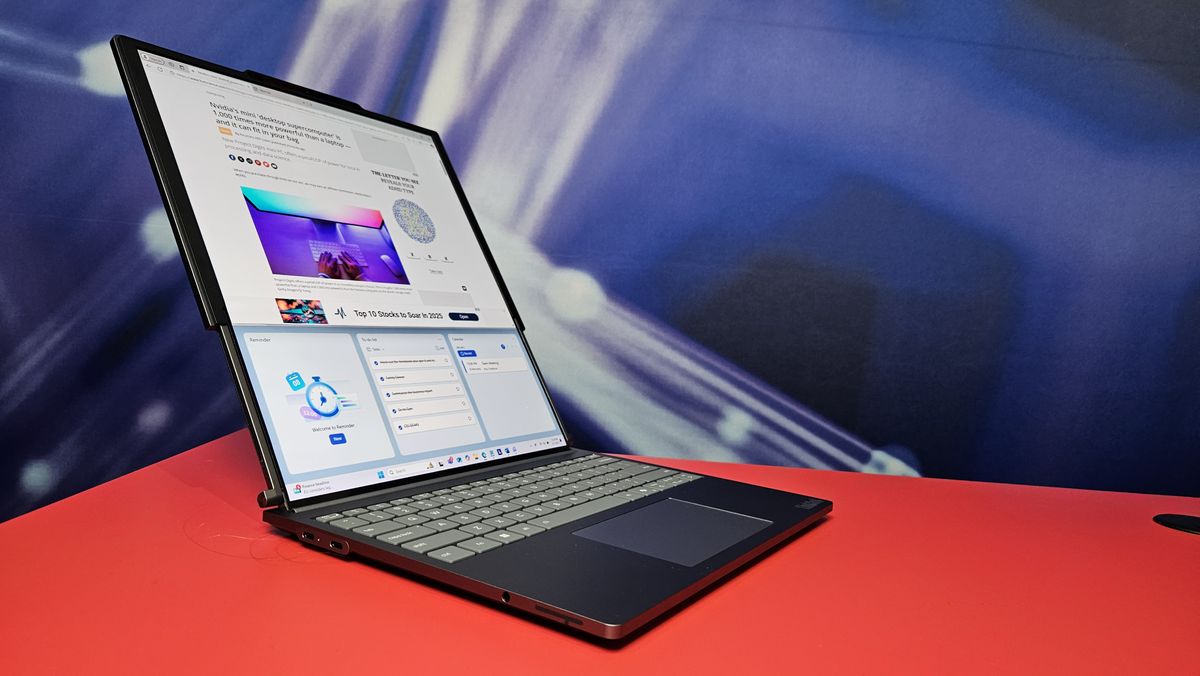
- Holographic windshield display
- A relaxation pendant
- An AI-powered reader for children's books
- Oil-based haptics
- AI noise isolation on a TV
- Paperlike digital art display
- Satellite internet peripheral
- 'Sound bubble' headset
- A fridge that can cook
- The first 'rollable' laptop
- First transparent and wireless TV
- Drunk driving detector
- Memory-boosting app
- Wearable 'memory capsule'
- Extended reality aviators
- Tiny ultrasonic loudspeaker
- Heating and cooling desk chair
- Battery-free wireless keyboard
LAS VEGAS — With CES 2025 in full swing, hundreds of innovators, engineers and manufacturers have descended on Las Vegas to showcase cutting-edge and exciting technologies. These range from devices that are set for commercial release to those that are more experimental in nature.
There are plenty of new technologies on show, with a significant number leaning on artificial intelligence (AI) — although there are plenty other technologies worth highlighting. Live Science is on the ground and we've selected a handful of innovations that have caught our eye so far.
1. World's 1st holographic windshield display

Drivers of future electric vehicles (EVs) could be using a holographic display that spans the breadth of their windshield. Developed alongside the optics company Zeiss, Hyundai Mobis' new windshield display is a first-of-its-kind innovation that projects key information, such as navigation and safety alerts, in a panoramic and immersive way. Mass production of this technology will begin in 2027, representatives said.
2. A haptic pendant that beats along to music
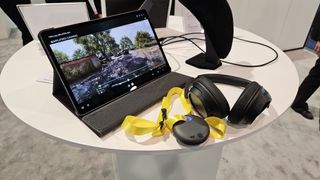
Titan is a company that builds advanced haptic motors (or small devices that generate vibrations in things that you hold) for smartphones and gaming devices— but its latest innovation is a relaxation device designed to be worn around the neck. "TITAN Ono" is a pendant that taps into "high definition" haptics to send vibrations through your chest based on a handful of pre-configured modes that may help entertain or calm you. You might, for example, want to feel the sensation of a cat purring, or a heart beating. The device can also be connected to Bluetooth headphones and deliver haptic sensations that accurately mimic the way your chest cavity resonates when you listen to booming live music.
3. An AI-powered reader for children's books
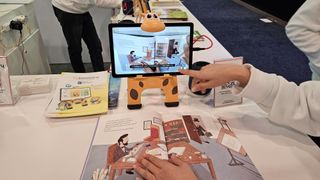
Winner of a CES 2025 Innovation Award, Woongjin ThinkBig's Booxtory is an AI-powered reading device that uses technology to outsource the effort of parents reading to their kidss. You can place a book down in front of the device and the onboard camera uses optical character recognition (OCR) technology to take in the words — with an in-house generative AI system reading out the words through a connected speaker. Its plethora of features includes switching between different preset voices, or even training the AI with a sample of your own voice.
4. The motor-free haptics technology that uses oil

Scientists from Japan have developed a new type of haptics technology called "SoftMRF" that can replicate specific textured feelings, like pushing your hands into the sand. Rather than using motors, the engineers add a small amount of oil into an actuator — a device that converts energy into mechanical motion — before running a current through it. The viscosity of the recreated oil changes with the magnetic field, which allows them to precisely control the level of resistance and the specific sensation you feel when you, for example, push a trigger on a joystick.
5. AI-powered TV that can isolate different sound sources

Toshiba has showcased a handful of ways that AI can transform the viewing experience at home. The highlight is an in-built software for your TV that detects different types of audio coming through — such as commentary and crowd noise during a sports game — and allows you to isolate one particular track at the push of a button. In another example, demonstrators isolated the voice of a reporter during a news segment — and then pushed a button to dampen the reporter's voice and broadcast just the sounds of traffic. The technology is still in development with no fixed release date.
6. The paperlike digital art display with a year-long battery life

InkPoster is the world's first low-power and high-resolution display that lets you upload and display full-color pieces of artwork on your walls using e-paper technology. The battery life lasts for up to a year on a single charge. The largest model has a 31.5-inch (80 centimeter) 2,560 x 1,440-pixel rectangular display — all featured in an aluminum frame with a matte finish. Each one is also Wi-Fi compatible and only needs a power supply when new images are being uploaded.
7. The satellite internet smartphone add-on
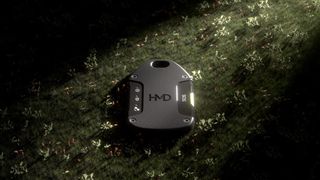
HMD OffGrid is ideal for anybody who's regularly on the move. This device can be linked with your smartphone to enable you to tap into satellite internet networks so you can carry on receiving and sending messages to friends and family while also beaming up regular location updates — especially in areas that have no internet or cellular signal whatsoever.
8. The headset that puts you in a "sound bubble"
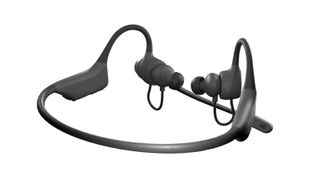
The Skyted 320 is a headset unlike any other — not only does the microphone isolate your voice, but the device itself creates an invisible sound bubble around you that makes sure nobody 2 feet (0.6 meters) away from you can hear your voice. The technology relies on lowering the sound threshold at which your voice can be picked up by the microphones, representatives said. The minimum voice level activation is 40 decibels, whereas most devices need you to speak at a volume of at least 90 dB — the microphones will also isolate your voice and dampen any background noise for the person you're speaking with.
9. A fridge that can cook

Figo is a refrigerator that fits on your countertops that can cook and store food until it is ready to be prepared with sous-vide cooking — a method of cooking that involves sealing food in a bag and submerging it in water heated to the precise temperatures required. This device lets people effortlessly schedule meals that they prepped a couple of days previously. The idea is to promote better food consumption habits, according to EatFigo representatives.
10. The first 'rollable' laptop
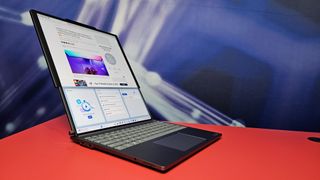
Lenovo has debuted a 2-in-1 laptop with a new rollable display, making it the first machine of its kind ever launched.
Related: Best laptops for photo editing 2025: Notebooks for designers and photographers
The ThinkBook Plus Gen 6 Rollable offers a second display above the standard 14-inch (35.5 cm) screen, extending the screen's real estate to 16.7 inches (42.4 cm). You can activate the additional screen space either by tapping a dedicated key or by making hand gestures to the camera. This form factor sets it apart from 360-degree 2-in-1 laptop-tablet hybrids or even foldable devices.
11. The first transparent and wireless TV
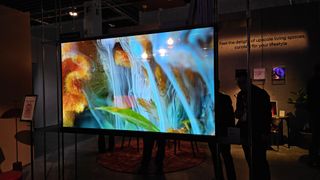
First debuting at CES 2024, LG's wireless and transparent 4K OLED TV, dubbed "Signature OLED T" is now commercially available — if you have at least $60,000 to spend. The "true wireless" technology that LG has given this device is amisnomer, given there are two standard power cables with the set-up that powers the display itself and a companion box. You can plug in any cabling, like HDMI, into the companion box, and set this anywhere in your home up to 30 feet (9 meters) away — ideally with a clear line of sight. The box then transmits the data to the panel itself via Wi-Fi.
12. Drunk driving detector
There have been several previous attempts to design an in-vehicle drunk driver detection system without the need for a breathalyzer, including an algorithm with 75% accuracy. But scientists at research company VinAI claim to have beaten that figure with "DrunkSense" — a passive detection system that scores 85%.
13. An app that can boost your memory, thanks to AI
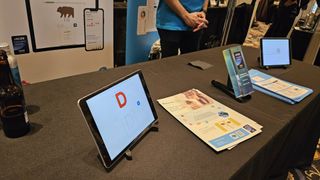
A memory-boosting app that's new to the U.S. is taking advantage of AI's ability to learn and improve with new training data. By asking you various questions, the app builds a profile of your memory before testing it and attempting to improve it over time by tailoring specific exercises to you to stretch it.
14. A wearable 'memory capsule' that records your voice
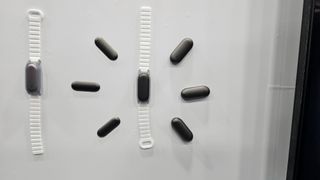
Note-taking and transcription are time-consuming, but plenty of software-based AI services can cut down the workload. Plaud AI takes this one step further with hardware-based note-taking devices that use large language models (LLMs). At CES 2025, company representatives showed off the NotePin, a device that can be worn on your wrist like a watch or around your neck like a pendant. With it, wearers can begin recording and transcribing at the push of a button.
15. Extended reality aviators that let you see your computer screen

Lenovo engineers have created a pair of aviator sunglasses fitted with optical technology that beams the screen from any PC, phone, laptop or tablet compatible with DisplayPort technology directly onto the lenses. It works by plugging it into a laptop, sitting back and using the sunglasses as a screen. Note, you'll still need to control your device with your keyboard and mouse (or touchpad).
16. A tiny, punchy ultrasonic loudspeaker for your phone, watch or glasses
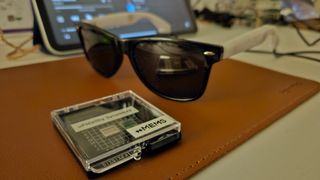
Phones, smart glasses and open wireless stereo (OWS) earbuds could soon deliver much punchier sound with a new 0.04-inch-thin (1 millimeter) chip that creates sound by generating waves above the human hearing range. The tiny "Sycamore" processor is three times thinner than dynamic drivers, xMEMS representatives told Live Science, and can be placed in various devices to deliver a much more consistent sound across all frequencies — including plenty more bass. This is thanks to components that tap into the piezoelectric effect to generate sound, like the same company's ultrasonic chip designed for earbuds and headphones.
17. A desk chair with inbuilt cooling and heating
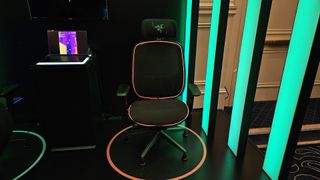
RAZER debuted a desk chair concept that incorporates a fan system that blows either warm or cool air at the push of a button. The integrated fan system sucks in air from the unit at the bottom and pipes it through the chair's skeleton, blowing the air out through grills where your neck would normally rest. The temperature of the air delivered can reach as high as 86 degrees Fahrenheit (30 degrees Celsius) while it reduces the perceived temperature by 35 to 41 F (19 to 22 C) versus room temperature.
18. A battery-free wireless keyboard
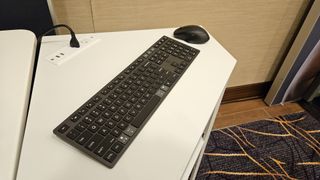
HP has created a wireless keyboard and mouse that don't rely on batteries — instead, the devices contain a supercapacitor, which has a much higher power density and faster charging time than batteries. Just three minutes of charging with a USB-C port can give the keyboard two months of life before running out of charge and one month for the mouse, Kevin Wentzel, HP's product experience strategist, told Live Science.
Sign up for the Live Science daily newsletter now
Get the world’s most fascinating discoveries delivered straight to your inbox.

Keumars is the technology editor at Live Science. He has written for a variety of publications including ITPro, The Week Digital, ComputerActive, The Independent, The Observer, Metro and TechRadar Pro. He has worked as a technology journalist for more than five years, having previously held the role of features editor with ITPro. He is an NCTJ-qualified journalist and has a degree in biomedical sciences from Queen Mary, University of London. He's also registered as a foundational chartered manager with the Chartered Management Institute (CMI), having qualified as a Level 3 Team leader with distinction in 2023.
